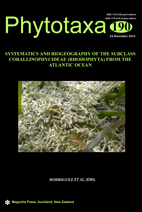Abstract
This is the first revision of Neogoniolithon species on the east coast of Mexico based on both DNA sequences (psbA) and morpho-anatomical characters. Nine species names are provisionally applied based on morpho-anatomical comparisons with type specimens or with species descriptions: N. accretum, N. acropetum, N. erosum, N. mamillare, N. propinquum, N. rhizophorae, N. solubile, N. spectabile and N. strictum. For none of these species was type or topotype material sequenced, but all have their type localities in the subtropical or tropical western Atlantic Ocean. Neogoniolithon siankanensis is described on the basis of a distinctive branched thallus, apical tetrasporangial conceptacles and DNA sequence. Another four species are present, each characterized by DNA sequence, but insufficient reproductive material was available to adequately describe these species. A suite of vegetative and reproductive characters can adequately segregate the currently named Mexican east coast Neogoniolithon species, including 1) branched versus unbranched thalli, 2) monomerous versus dimerous construction, 3) disposition of trichocytes, 4) interior dimensions of mature tetrasporangial conceptacles, 5) number of cell layers comprising tetrasporangial conceptacle roof and 6) shape of cells that line tetrasporangial pore canal. Morpho-anatomical descriptions and distributions are provided for all named species.

